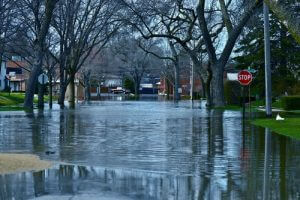Happy August, everyone!

Here in Florida, the month is practically synonymous with thunderstorms. Although traditionally our rainiest month of the year, August 2015 seems to truly be one for the record books. Tampa, for instance, typically gets 5-9 inches each August. As of today (August 6), the city’s already had 7.8. In the past two weeks, it’s been more than 20!!!
For a low-lying city on a bay, that type of rainfall means a whole lot of flooding. I visited my boyfriend there last weekend. His immediate neighborhood only had patches of water (about 1-inch deep), but all the major arteries around him were closed, keeping us from about 90% of restaurants, grocery stores, etc.
For us, it was just an inconvenience. But as I’ve watched the news all week, it’s become clear that, for many residents, the near constant rain has been a very costly burden. (And full of dangers — one t.v. reporter encountered a water moccasin while wading through a flooded mobile home park. YIKES!) I couldn’t help but think of the small business owners unable to get to work or whose customers cannot get to them. I’ve wondered about the florists and how they’ve managed to make deliveries.
Flooding is Florida’s reality, but natural disasters came in all shapes and sizes –wildfires, tornadoes, earthquakes, sinkholes, wind (remember the 2012 derecho that left DC dark for almost a week?). There’s no preventing catastrophes, but you can prepare for them.
If you don’t have a plan in place, it’s worth taking a few minutes to read on for some advice from Julie Bawden Davis, a contributing writer for American Express’ Open Forum:
Record-setting summer rains in drought-stricken California this past week and the resulting flash floods and damage, including a failed bridge, had a lot of people scrambling. The two-day July rainstorm is an example of the sudden curveballs small-business owners commonly have to deal with.
“Just when you think things are cool, wham! A sucker punch,” says Peter Boni, managing principal of Kedgeway, Inc. and author of All Hands On Deck: Navigating Your Team Through Crises, Getting Your Organization Unstuck, and Emerging Victorious. “It happens to outfits big and small. Sometimes it’s self-induced. The culprit could be lack of foresight and planning, or just bad management. Other times, external forces beyond anyone’s control can whack you.”
Catastrophic Events
“Natural disasters happen all the time all over the United States, from the floods in California and Texas, to the tornadoes in the Midwest, or hurricanes,” adds Bill McBean, author of The Facts Of Business Life: What Every Successful Business Owner Knows That You Don’t. “Successful business owners understand one important reality from those owners who are just hanging on or have had to close their businesses. They understand that what can be controlled must be. And what can’t be controlled has to be contained.”
Natural disasters can’t be controlled, but adequate insurance coverage can go a long way to helping lessen the blow of the unexpected, McBean notes. “[You should] realize the importance of asset protection, that profits or sales would not be possible if the assets of the business aren’t protected. In reality, asset protection is more important than sales and profits, because assets create the tools and the inventory from which profits and sales are generated. Assets represent cash or credit already spent, and not protecting them is equivalent to leaving thousands of dollars on a park bench and hoping no one will take it.
Always break down your assets into the controllable and uncontrollable ones,” McBean adds. “Then make intelligent decisions regarding all your assets in terms of how they can be protected after a disaster, so your business can survive to fight for market share when things calm down.”
Whatever you do when presented with a challenge, don’t go it alone, Boni suggests. “The realization that you can’t handle things all by yourself is tough for some small-business people to recognize, but it’s imperative that you create a crisis team to help pull you through. Reach out to your staff, advisors and vendors and ask for assistance.”
Other ways to prepare for disaster are to:
- Develop a written, documented disaster preparedness plan and review it with your employees. Determine how you will communicate with one another in the event of a crisis, and make sure the information includes emergency contact information for everyone.
- Communicate your disaster preparedness plan. Hold a meeting and run through potential disasters. Discuss your first and future steps.
- Determine chain of command. Designate an employee to take over if you’re out of town and unreachable. You need someone steering the ship while you’re gone.
- Share your plan with critical external contacts. If you rely heavily on outside vendors, such as computer support people, share your potential disaster plan with them so they know what to expect and do if something does occur.
- Decide on an alternative operation site. The last thing you want to do if a natural disaster strikes is to scramble to find an alternate location. Decide ahead of time where that will be.
- Back up frequently. Loss of data is often a small-business owner’s biggest potential threat. You should ideally be backing up every day. Backing up into a cloud can help ensure your data is safe.
